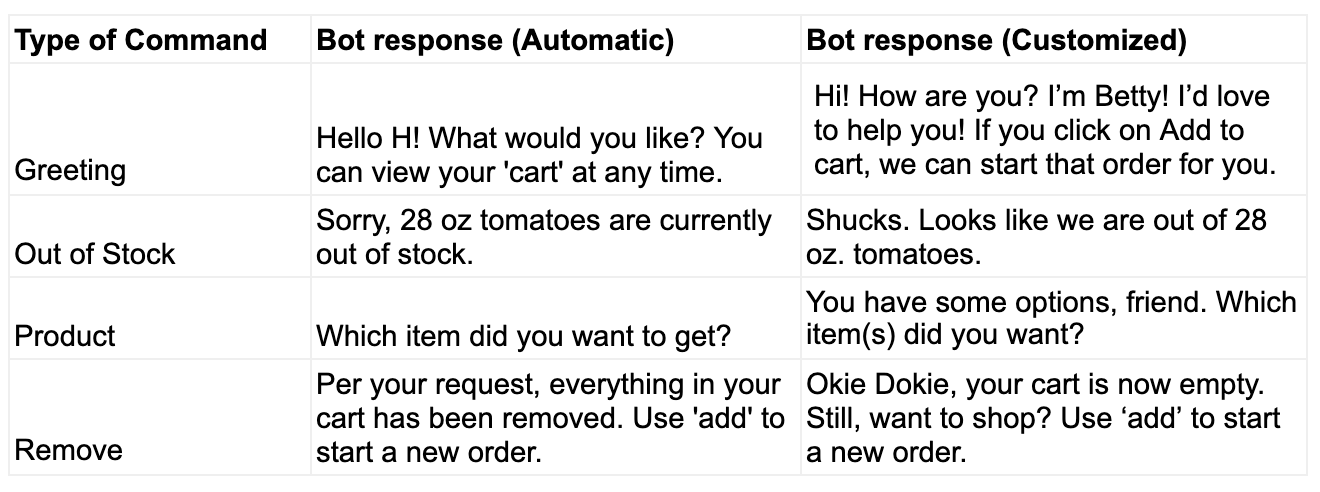Learn more on www.bloomreach.com >
How to Design a Commerce Chatbot that Matches Your Brand
Congratulations! You’ve invested in a platform, and you are ready to start building your chatbot. Now what? Since the chatbot is a brand ambassador and may be a customer’s first experience with your company, make sure the design reflects your brand every step of the way.
Here are some tips to help you design a chatbot that leaves a positive impression.
Choose a Dumb or Smart Chatbot
The first decision you need to make is what kind of chatbot interaction your customers will have. Chatbots can be broken down into two types: dumb and smart.
“Dumb” (Simple) Chatbot
A dumb chatbot responds to basic information and only that information. Think of an automated voicemail system--press 1 for the directory, 2 for sales, 0 to speak with a person. If you press a number that isn’t in its directory, it doesn’t know how to respond. A dumb bot is programmed to respond to a fixed set of responses and only that.
A simple chatbot interaction might go something like this:
Chatbot: Hi! My name is Betty! How can I help you today?
Customer: What are your hours of operation?
Chatbot: We are open Monday to Friday from 10 to 5 p.m. PT. Saturday from 10 to 6 p.m. PT We are closed Sundays.
Customer: Do you offer curbside pickup?
Chatbot: I’m sorry, I didn’t understand the question. Here is the customer service phone number: [inserts phone number]
Dumb bots work best for businesses that don’t anticipate a lot of customer interaction with the bot or want a bot to provide basic information like hours of operation, contact customer service or contact the store.
You can also use dumb bots for outbound marketing, sending messages about upcoming sales or special promotions, reminding them to re-order supplies and other straightforward interactions.
“Smart” Chatbot
Smart chatbots--like those powered by machine learning/artificial intelligence (AI)--can interact with your customers similar to how a customer service person would interact.
A smart chatbot will learn over time from customer interactions and is better able to address ambiguity. So, the next time a customer inquires about something that does not have a pre-programmed response, the smart chatbot can help further guide the customer on their journey..
The “smarter” your chatbot is, the more of an investment of time will be required since you need to set up and train the bot like any other new hire.
You need to program the bot, decide what data it will have access to, such as service manuals, catalogues, previous customer correspondence, etc., then program the responses, monitor the interactions and set filters if necessary.
Design in Accordance with Your Brand
Once you know what kind of chatbot you want, it’s time to think about your brand. It can help to first make a list of the attributes of your brand and then incorporate them into the bot.
Ensure you have a clear vision of what type of interaction you want your customers to have, what experience they will have and how they will feel afterwards.
Draw upon the information in your copywriting and advertising guidelines for inspiration. The more you think about what your brand would feel like, the better you can design a chatbot that reflects it.
Remember, your bot may be the customer’s first (and possibly only) interaction with your company, so make it memorable and representative of your brand.
Create a Chatbot Persona
If your chatbot was sitting across from you having lunch, who would be sitting there? Now is the time to create your chatbot persona.
Give the chatbot a name. And explore questions like:
- Would the chatbot be old, young, married, single, a professional, student or entrepreneur?
- What gender is the chatbot representing?
- How would they speak—would they use slang, formal sentences? Would they say “hi,” “hello” or “hey,” “you” or “y’all”?
- Are they friendly, calm or funny?
- If they text, would they use abbreviations, full sentences or emojis and multiple exclamation points?
Think of your ideal customers, and use them as inspiration for designing your chatbot’s personality.
Here are some examples of how a chatbot could be programmed from the standard out-of-the-box response to something that represents a brand’s personality:

Final Thoughts
From routine inquiries about hours of operation, location and return policies to helping clients choose the right product for their needs and beyond, chatbots can be an extension of your brand and provide a positive customer experience.
Plus, adding a chatbot can greatly reduce customer service workload, leaving staff with more time to deal with more complicated tasks.
Because chatbots are an extension of your brand and they could be the first (or last) encounter with your company, take the time to decide what kind of persona you want your chatbot to have and how to represent your brand.
Just as you would want employees to be a positive representation of your company, so should your chatbot.
And, remember, the best chatbot is still no substitute for human interaction, so always build in a way for your customers to reach a live person.

